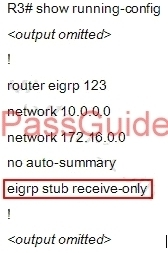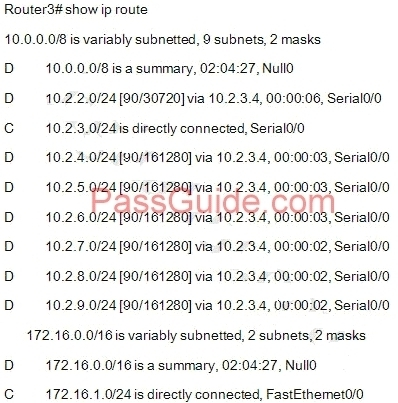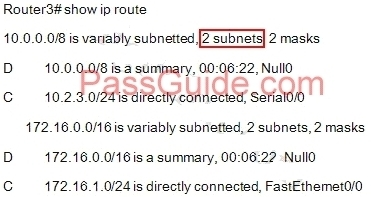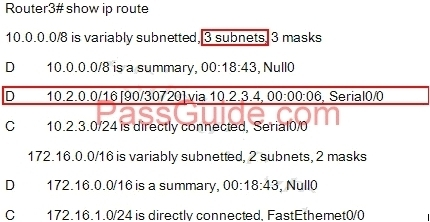LAB
By increasing the first distant office, JS manufactures has extended their business. They configured the remote office router (R3) from which they can reach all Corporate subnets. In order to raise network stableness and lower the memory usage and broadband utilization to R3, JS manufactures makes use of route summarization together with the EIGRP Stub Routing feature. Another network engineer is responsible for the implementing of this solution. However, in the process of configuring EIGRP stub routing connectivity with the remote network devices off of R3 has been missing.
Presently JS has configured EIGRP on all routers in the network R2, R3, and R4. Your duty is to find and solve the connectivity failure problem with the remote office router R3. You should then configure route summarization only to the distant office router R3 to complete the task after the problem has been solved.
The success of pings from R4 to the R3 LAN interface proves that the fault has been corrected and the R3 IP routing table only contains two 10.0.0.0 subnets.
Answer and Explanation:
First we have to figure out why R3 and R4 can not communicate with each other. Use the show running-config command on router R3
Notice that R3 is configured as a stub receive-only router. The receive-only keyword will restrict the router from sharing any of its routes with any other router in that EIGRP autonomous system. This keyword will also prevent any type of route from being sent. Therefore we will remove this command and replace it with the eigrp stub command:
R3#configure terminal
R3(config)#router eigrp 123
R3(config-router)#no eigrp stub receive-only
R3(config-router)#eigrp stub
R3(config-router)#endNow R3 will send updates containing its connected and summary routes to other routers. Notice that the eigrp stub command equals to the eigrp stub connected summarybecause the connected and summary options are enabled by default. Next we will configure router R3 so that it has only 2 subnets of 10.0.0.0 network. Use the show ip route command on R3 to view its routing table
R3#show ip route
Because we want the routing table of R3 only have 2 subnets so we have to summary sub- networks at the interface which is connected with R3, the s0/0 interface of R4. There is one interesting thing about the output of the show ip route shown above: the 10.2.3.0 /24, which is a directly connected network of R3. We can’t get rid of it in the routing table no matter what technique we use to summary the networks. Therefore, to make the routing table of R3 has only 2 subnets we have to summary other subnets into one subnet. In conclusion, we will use the ip summary-address eigrp 123 10.0.0.0 255.0.0.0 at the interface s0/0 of R4 to summary.
R4>enable
R4#configure terminal
R4(config)#interface s0/0
R4(config-if)#ip summary-address eigrp 123 10.0.0.0 255.0.0.0Now we jump back to R3 and use the show ip route command to verify the effect, the output is shown below:
(But please notice that the ip addresses and the subnet masks in your real exam might be different so you might use different ones to solve this question) Just for your information, notice that if you use another network than 10.0.0.0/8 to summary, for example, if you use the command ip summary-address eigrp 123 10.2.0.0 255.255.0.0 you will leave a /16 network in the output of the show ip route command.
But in your real exam, if you don’t see the line “10.0.0.0/8 is a summary,….Null0” then you can summary using the network 10.2.0.0/16. This summarization is better because all the pings can work well.
Finally don’t forget to use the copy running-config startup-config command on routers R3 and R4 to save the configurations.R4(config-if)#end
R4#copy running-config startup-config






